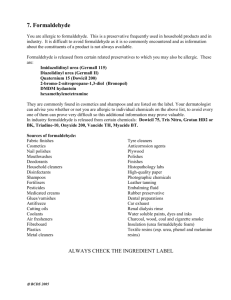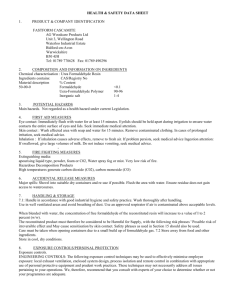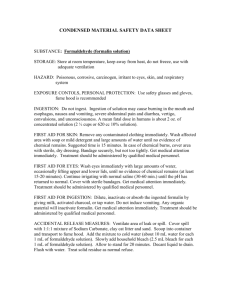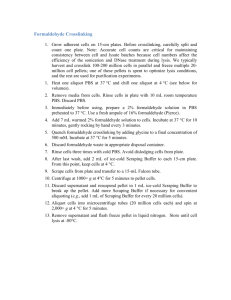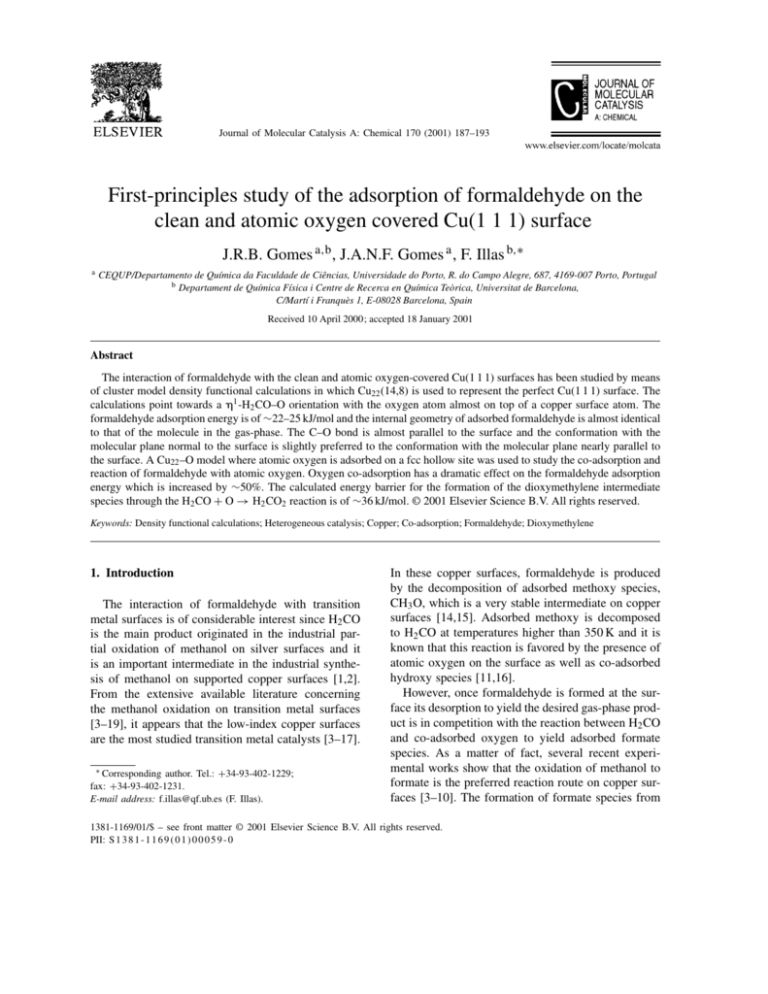
Journal of Molecular Catalysis A: Chemical 170 (2001) 187–193
First-principles study of the adsorption of formaldehyde on the
clean and atomic oxygen covered Cu(1 1 1) surface
J.R.B. Gomes a,b , J.A.N.F. Gomes a , F. Illas b,∗
a
CEQUP/Departamento de Quı́mica da Faculdade de Ciências, Universidade do Porto, R. do Campo Alegre, 687, 4169-007 Porto, Portugal
b Departament de Quı́mica Fı́sica i Centre de Recerca en Quı́mica Teòrica, Universitat de Barcelona,
C/Martı́ i Franquès 1, E-08028 Barcelona, Spain
Received 10 April 2000; accepted 18 January 2001
Abstract
The interaction of formaldehyde with the clean and atomic oxygen-covered Cu(1 1 1) surfaces has been studied by means
of cluster model density functional calculations in which Cu22 (14,8) is used to represent the perfect Cu(1 1 1) surface. The
calculations point towards a 1 -H2 CO–O orientation with the oxygen atom almost on top of a copper surface atom. The
formaldehyde adsorption energy is of ∼22–25 kJ/mol and the internal geometry of adsorbed formaldehyde is almost identical
to that of the molecule in the gas-phase. The C–O bond is almost parallel to the surface and the conformation with the
molecular plane normal to the surface is slightly preferred to the conformation with the molecular plane nearly parallel to
the surface. A Cu22 –O model where atomic oxygen is adsorbed on a fcc hollow site was used to study the co-adsorption and
reaction of formaldehyde with atomic oxygen. Oxygen co-adsorption has a dramatic effect on the formaldehyde adsorption
energy which is increased by ∼50%. The calculated energy barrier for the formation of the dioxymethylene intermediate
species through the H2 CO + O → H2 CO2 reaction is of ∼36 kJ/mol. © 2001 Elsevier Science B.V. All rights reserved.
Keywords: Density functional calculations; Heterogeneous catalysis; Copper; Co-adsorption; Formaldehyde; Dioxymethylene
1. Introduction
The interaction of formaldehyde with transition
metal surfaces is of considerable interest since H2 CO
is the main product originated in the industrial partial oxidation of methanol on silver surfaces and it
is an important intermediate in the industrial synthesis of methanol on supported copper surfaces [1,2].
From the extensive available literature concerning
the methanol oxidation on transition metal surfaces
[3–19], it appears that the low-index copper surfaces
are the most studied transition metal catalysts [3–17].
∗ Corresponding author. Tel.: +34-93-402-1229;
fax: +34-93-402-1231.
E-mail address: f.illas@qf.ub.es (F. Illas).
In these copper surfaces, formaldehyde is produced
by the decomposition of adsorbed methoxy species,
CH3 O, which is a very stable intermediate on copper
surfaces [14,15]. Adsorbed methoxy is decomposed
to H2 CO at temperatures higher than 350 K and it is
known that this reaction is favored by the presence of
atomic oxygen on the surface as well as co-adsorbed
hydroxy species [11,16].
However, once formaldehyde is formed at the surface its desorption to yield the desired gas-phase product is in competition with the reaction between H2 CO
and co-adsorbed oxygen to yield adsorbed formate
species. As a matter of fact, several recent experimental works show that the oxidation of methanol to
formate is the preferred reaction route on copper surfaces [3–10]. The formation of formate species from
1381-1169/01/$ – see front matter © 2001 Elsevier Science B.V. All rights reserved.
PII: S 1 3 8 1 - 1 1 6 9 ( 0 1 ) 0 0 0 5 9 - 0
188
J.R.B. Gomes et al. / Journal of Molecular Catalysis A: Chemical 170 (2001) 187–193
methanol oxidation has also been observed on when
the reaction is catalyzed by silver surfaces [18], the
industrial catalyst used nowadays in the production
of formaldehyde from methanol. However, it is worth
pointing out that this route is in disagreement with the
conclusions reached by previous works based on different experimental techniques. In fact, from temperature programmed desorption (TPD) studies [12,13],
albeit in a rather limited range of experimental conditions, formaldehyde was observed as the major product
of the methanol oxidation and, hence it was assumed
that the formate formation pathway was unfavorable
on copper surfaces. Similarly, Barnes et al. [17] performed a molecular beam study and concluded that no
significant amounts of formate were produced.
The understanding of the mechanisms of methanol
oxidation catalyzed by metal surfaces requires a detailed knowledge of the adsorption and reaction modes
of the different species involved in the reaction. In this
paper, we present a theoretical study of one of the elementary steps involving methanol oxidation catalyzed
by metals. This includes the adsorption mode and adsorption energy of formaldehyde on a clean and oxygen covered copper surface. This work follows a previous research in the same overall catalytic process
that was devoted primarily to the study of the methoxy
to formaldehyde reaction [16].
This work is organized as follows: details of cluster
models and theoretical method employed to perform
the present study are given in Section 2. The geometric parameters and vibrational frequencies of free
and adsorbed formaldehyde are discussed in Section
3. Section 4 shows the pathway for the reaction between adsorbed formaldehyde and co-adsorbed atomic
oxygen on the Cu(1 1 1) surface to yield the adsorbed
dioxymethylene species (H2 CO2 ). Also, in Section 4,
details about the transition state for the H2 CO + O →
H2 CO2 surface reaction are presented. Finally, in Section 5, the most important conclusions of the present
work are summarized.
2. Computational details
The present work is devoted to the study of the interaction of formaldehyde with the Cu(1 1 1) surface.
For that purpose, the B3LYP density functional theory, DFT, based three-parameter hybrid method pro-
Fig. 1. Top view of the Cu22 (14,8) cluster used to model the
Cu(1 1 1) surface. Dark and light grey atoms belong to the inner
and outer regions, respectively.
posed by Becke was used. This method comprises an
exchange functional that mixes the non-local Fock exchange with gradient corrected form of Becke [20] and
adds the functional correlation proposed by Lee et al.
[21] based in the previous work of Colle and Salvetti
[22,23]. The Cu(1 1 1) metal surface was modeled by
the Cu22 (14,8) cluster shown in Fig. 1. This metal cluster is a section of the ideal (1 1 1) copper surface with
a Cu–Cu nearest-neighbor distance of 2.551 Å taken
from the bulk. The cluster metal–metal distances have
been kept frozen during calculations.
Depending on the orientation of the formaldehyde
molecular plane with respect to the metal surface, the
different adsorption conformations that have been explicitly studied can be divided in two groups. In the
first group, the molecular plane is normal to the surface and the three-conformations studied are shown in
the left-hand side of Fig. 2. These are the 1 -H2 CO
conformations with the formaldehyde carbon (A) or
oxygen (B) atoms directly above one surface copper
atom, and that where the formaldehyde oxygen atom
is placed above a fcc three-fold site (C). In the second
group, the formaldehyde molecular plane is parallel
to the copper surface and the conformations considered in this study are shown in the right-hand side of
Fig. 2. Two 2 -H2 CO conformations with the carbon
and oxygen atoms placed above the surface and along
J.R.B. Gomes et al. / Journal of Molecular Catalysis A: Chemical 170 (2001) 187–193
189
ing electrons are described by the LANL2DZ basis
which is of double- quality. For the copper atoms
that belong to the outer region, the same small core
ECP is used, but the valence electrons are described
by means of the smaller LANL2MB basis set. All calculations were carried out by means of the Gaussian
98 package [25].
3. Adsorption of formaldehyde on Cu(1 1 1)
Fig. 2. Top view of the initial positions for formaldehyde adsorbed
on Cu(1 1 1) with the molecular plane normal (structures A, B
and C) or parallel (structures D, E and F) to the metallic surface:
(A) 1 -H2 CO–C on a top site; (B) 1 -H2 CO–O on a top site; (C)
1 -H2 CO–O on a fcc hollow site; (D) 2 -H2 CO on a short-bridge
site; (E) 2 -H2 CO on a cross-bridge site; (F) 1 -H2 CO–O on a
top site.
the short-bridge (D) or the long-bridge (E) sites were
studied and a 1 -H2 CO conformation with the oxygen atom on top of a copper atom (F). Nevertheless,
the purpose of the above discussion is to provide reasonable starting geometries. The final stable structures
have always been obtained from a full geometry optimization process of the adsorbate coordinates using
analytical gradients and always maintaining a symmetry plane perpendicular to the surface. In one special
case, a search for the reaction transition state has been
carried out, vide infra.
The B3LYP calculations have been carried out in
the LCAO framework with the Kohn-Sham orbitals
expressed in terms of Gaussian-type orbitals (GTO).
For the non-metallic atoms all electrons are explicitly
included and the standard 6-31G∗∗ GTO basis set is
used. The surface cluster model is divided in local and
outer regions. The atoms in the local region are those
directly interacting with the adsorbed species whereas
the rest of cluster atoms define the outer region, cf.
Fig. 1. Two different basis sets are used for the metal
atoms depending on whether they belong or not to
the local region. For the atoms in the local region, the
1s2 2s2 2p6 core electrons are included in the relativistic small core LANL2 effective core potential, ECP,
proposed by Hay and Wadt [24], whereas the remain-
The final formaldehyde adsorption conformations
obtained by performing total geometry optimization
starting from the initial structures in Fig. 2, are depicted in Figs. 3 and 4. From the possible conformations with the formaldehyde molecular plane perpendicular to the surface that have been described in the
previous section, a unique final perpendicular conformation appears. In fact, starting the geometry optimization procedure from A, B or C leads always to the
same final conformation, structure G in Fig. 3. On the
other hand, two different conformations are predicted
with the molecular plane nearly parallel to the surface. These structures are labeled as H and I in Fig. 3,
structure H is obtained from the D initial structure,
whereas I appears to be the final optimized geometry
starting from either E or F. Side views of structures G,
H and I are presented in Fig. 4. A common feature to
adsorption structures G, H and I is that formaldehyde
prefers an adsorption mode where the oxygen atom is
Fig. 3. Top view of the optimized geometries — G, H and I — for
formaldehyde adsorbed on the Cu(1 1 1) surface. Starting structures
in Fig. 2 lead to the G, H and I final geometries (see text).
190
J.R.B. Gomes et al. / Journal of Molecular Catalysis A: Chemical 170 (2001) 187–193
Fig. 4. Optimized geometries for formaldehyde adsorbed on the Cu(1 1 1) surface. Labels G, H and I stand for the structures depicted also
in Fig. 3. Only a few surface atoms are displayed.
located directly above a surface copper atom. In any of
these situations, the optimized geometry of adsorbed
formaldehyde is very close to that corresponding to
the gas-phase molecule, and accordingly, formaldehyde is weakly adsorbed, E ads ∼ 22–25 kJ/mol. The
larger adsorption energy corresponds to the G final
structure, E ads ∼ 24.8 kJ/mol, although this figure
is very close to the values computed for structures
H and I, E ads ∼ 22.9 and 22.4 kJ/mol, respectively.
As stated above, the internal geometric parameters of
the adsorbed formaldehyde molecule are identical to
those computed for the gas-phase molecule. This is
due to the weak interaction of formaldehyde with the
Cu(1 1 1) surface also indicated by the fairly large perpendicular distance from H2 CO to the surface. The
almost negligible geometry change with respect to the
gas-phase values and the weak interaction energy are
consistent with a strong tilting of the C–O bond of
formaldehyde away from the surface normal, in all
cases. For a strong chemisorption bond dominated by
a backdonation mechanism as for CO on metal surfaces [26–29], there is a large energy costs to tilt the
molecule [30]. The energy required to tilt the molecule
is much smaller, when the bond is not directional. In
this case, the Pauli repulsion and the electrostatic interaction govern the magnitude of the tilting. The large
tilting angle calculated for adsorbed formaldehyde is
in agreement with the findings of Bowker et al. [31]
for adsorption of formaldehyde on Cu(1 1 0). From
the photoelectron spectra, these authors conclude that
formaldehyde interacts with the surface by the in plane
O 2p orbital and in a conformation with the molecular plane parallel to the surface close to the calculated structure H. Likewise, the tilting angle for the
most stable structure, G is approximately 75◦ , is in
nice agreement with the experimental conformation
proposed for formaldehyde on the Ag(1 1 1) surface
[32]. These authors, found a tilting angle of 57◦ ± 6◦
and predict a conformation rather reminiscent of structure, G, where the formaldehyde molecular plane is
quasi-perpendicular to the surface.
Finally, we remark that since the internal geometry
of adsorbed formaldehyde is identical to the geometry
of the molecule in the gas-phase, similar IR spectra for
the adsorbed and gas-phase forms are to be expected
from the transferability of the normal modes [33]. This
is indeed confirmed by proximity of the vibrational
frequencies obtained from experimental data for both
formaldehyde adsorption on copper [34] and on silver
[35] surfaces, and for the gas-phase molecule [36,37].
4. Co-adsorption of formaldehyde and atomic
oxygen on Cu(1 1 1)
In order to study the influence of co-adsorbed
oxygen on the geometry and adsorption energy of
formaldehyde, cluster models with co-adsorbed oxygen and formaldehyde have also been employed. The
changes in both geometry and adsorption energy of
J.R.B. Gomes et al. / Journal of Molecular Catalysis A: Chemical 170 (2001) 187–193
191
Fig. 5. Geometric and energetic variation during the co-adsorption and reaction of formaldehyde with atomic oxygen on the Cu(1 1 1)
surface. J corresponds to the reactants — H2 CO(g) + O(ads) , K represents the H2 CO(ads) + O(ads) co-adsorbed species and is taken as the
zero reference energy, L stands for the approximate H2 CO····O(ads) transition state structure and, finally, M represents the H2 CO2(ads)
reaction product. Only a few surface atoms are displayed.
adsorbed formaldehyde in the I structure originated
by this co-adsorption are displayed in Fig. 5. The
choice of this I structure follows from the fact that
this structure is possibly the most adequate starting
structure for the search of the transition state of the
H2 CO + O → H2 CO2 reaction. This is in agreement
with the fact that H2 CO2 was previously found to adsorb preferentially on the long-bridge site [38]. Due
to the increase of computational effort in the search
of the transition state structure, the copper atoms in
the outer region were described as one-electron pseudoatoms and the 4s electron described by a contracted
double- basis set. The ECP and basis set parameters
for the Cu one-electron atoms are those reported by
Bagus et al. [39] and used very recently to study the
mechanism of propyne catalytic coupling on Cu(1 1 1)
[40]. Nevertheless, once the transition state structure
is located, the total energy is computed using the
LANL2 ECP and the corresponding basis sets for the
local and outer regions as described above. It is worth
pointing out that the full optimization of the adsorbed
dioxymethylene species, M using this more approximate description yields results that are identical to
those from reference [38]. In the co-adsorption studies, the oxygen atom is placed above an fcc hollow
site which was previously assigned as the one that stabilizes more efficiently atomic oxygen on single metal
surfaces [41]. The comparison of the internal geo-
192
J.R.B. Gomes et al. / Journal of Molecular Catalysis A: Chemical 170 (2001) 187–193
metry of formaldehyde I and K structures shows that
the C–O bond is slightly longer, when atomic oxygen is co-adsorbed, while the internal angles remain
unchanged. Moreover, oxygen co-adsorption causes a
decrease in the formaldehyde oxygen atom distance to
the surface and an increase in the atomic co-adsorbed
oxygen to the surface distance. The interaction energy
of adsorbed formaldehyde in presence of co-adsorbed
oxygen can be calculated as the difference between the
total energy of H2 CO + O adsorbed on Cu(1 1 1) and
the total energy of separate H2 CO and O–Cu(1 1 1)
fragments. From the value, thus, computed it follows
that the interaction of both adsorbed species on the
copper surface increases the adsorption energy of
formaldehyde by 56%. Another consequence of oxygen co-adsorption is that when oxygen is present, the
molecular plane of formaldehyde is less tilted away
from the parallel to the surface. Following previous
work [16], the transition state for the reaction between
co-adsorbed H2 CO and atomic oxygen structures to
yield dioxymethylene was approximated by performing a scan of the formaldehyde carbon atom to the
co-adsorbed oxygen distance, but with a full optimization of the rest of coordinates of the adsorbed
species. The transition state structure, thus, computed
is displayed in Fig. 5-L and the energy barrier for this
reaction is 35.7 kJ/mol. This low calculated value is in
agreement with the experimental fact that the reaction
between formaldehyde and adsorbed oxygen on the
Cu(1 1 0) surface occurs readily below 300 K [31]. In
the transition state structure the C–O bond is weaker
than in structure K as can be seen from the corresponding interatomic distance that is 0.05 Å longer.
In the transition state, the distance corresponding to
the bond that is being formed between formaldehyde
and co-adsorbed oxygen, C····O, is 1.840 Å, much
shorter than the value in structure K, 2.708 Å. The
approach of the formaldehyde molecule towards the
co-adsorbed oxygen atom is accompanied by a weakening of the bond between this atomic oxygen and the
copper surface. The low energy barrier calculated for
this reaction is an indication that dioxymethylene may
be the intermediate between formaldehyde and formate species in the methanol oxidation reaction path.
The fact that dioxymethylene is not observed in the
experimental studies could be attributed to the high
reactivity of this species. This is in agreement with
results reported in a previous work that for the overall
H2 CO + O → H2 CO2 → HCO2 reaction, estimates
the exothermicity in more than 200 kJ/mol [38].
5. Conclusions
The DF results reported in this work, for formaldehyde adsorption on the Cu(1 1 1) surface predict that,
in any of the sites considered, this species is only
weakly adsorbed. Six starting geometries were considered and, after optimization, three different conformations have been reached. These conformations
are rather similar since the oxygen atom of formaldehyde sits above one copper atom of the surface in
a 1 -H2 CO–O coordination. The three optimized geometries have close total energies and the internal geometry is almost indistinguishable from that corresponding to the gas-phase molecule. The C–O axis of
formaldehyde is rather tilted with respect to the surface, the C–O bond being almost parallel to the surface plane. These results are in agreement with experimental data obtained for formaldehyde adsorbed
on copper and silver surfaces. From the three stable
structures, the conformation with the molecular plane
normal to the surface is slightly preferred to those
with the molecular plane nearly parallel to the surface. The weak interaction with the surface and the
almost unchanged internal structure with respect to
the gas-phase geometry leads to vibrational frequencies for the adsorbed molecule that are expected to be
very close to gas-phase values, this is confirmed by
key calculations.
The co-adsorption of formaldehyde and atomic oxygen on the Cu(1 1 1) surface has also been studied.
The co-adsorption of oxygen and H2 CO was studied
with the aldehyde molecule adsorbed above one copper atom of a long-bridge site with the co-adsorbed
oxygen above a fcc site. It is found that the presence
of atomic oxygen on the surface stabilizes formaldehyde by 15 kJ/mol. Moreover, a transition structure for
the H2 CO+O → H2 CO2 reaction has been proposed.
An important feature of the transition state structure
is that the formaldehyde molecule is no longer planar.
The geometry of the adsorbed dioxymethylene, which
is the reaction product species, is in good agreement
with that calculated previously using a slightly different cluster model [38]. The predicted energy barrier
for the H2 CO + O → H2 CO2 reaction is 36 kJ/mol
J.R.B. Gomes et al. / Journal of Molecular Catalysis A: Chemical 170 (2001) 187–193
and the final product is 33 kJ/mol more stable than
the co-adsorbed species. The low energy barrier calculated for this reaction is an indication that dioxymethylene may be the intermediate between formaldehyde
and formate species in the methanol oxidation reaction path. These findings explain why some authors
[4] claim that formaldehyde desorption is in competition with the reaction between formaldehyde and
pre-adsorbed oxygen leading to formate.
Acknowledgements
This research has been supported by the Portuguese Fundação para a Ciência e a Tecnologia,
project PRAXIS/3/3.1/MMA/1780/95, the Spanish
DGICYT, project PB98-1216-C02-01 and, in part,
by Generalitat de Catalunya, grant 1999SGR-00040.
J.R.B.G. thanks the Fundação para a Ciência e a Tecnologia for a post-doc grant (BPD/22098/99). Part
of the computer time was provided by the Centre de
Supercomputació de Catalunya, CESCA, and Centre
Europeu de Paral.lelisme de Barcelona, CEPBA.
References
[1]
[2]
[3]
[4]
[5]
[6]
[7]
[8]
[9]
[10]
[11]
[12]
J.F. Walker, Formaldehyde, Reinhold, New York, NY, 1964.
K. Klier, Adv. Catal. 11 (1982) 243.
S.S. Fu, G.A. Somorjai, J. Phys. Chem. 96 (1992) 4542.
A.F. Carley, P.R. Davies, G.G. Mariotti, S. Read, Surf. Sci.
364 (1996) L525.
A.F. Carley, A. Chambers, P.R. Davies, G.G. Mariotti, R.
Kurian, M.W. Roberts, J. Chem. Soc., Faraday Disc. 105
(1996) 225.
P.R. Davies, G.G. Mariotti, J. Phys. Chem. 100 (1996) 19975.
P.R. Davies, G.G. Mariotti, Catal. Lett. 43 (1997) 261.
S. Poulston, A.H. Jones, R.A. Bennett, M. Bowker, J. Phys.
Condens. Matter 8 (1996) L765.
M. Bowker, S. Poulston, R.A. Bennett, A.H. Jones, Catal.
Lett. 43 (1997) 267.
A.H. Jones, S. Poulston, R.A. Bennett, M. Bowker, Surf. Sci.
380 (1997) 31.
J.N. Russel, S.M. Gates, J.T. Yates, Surf. Sci. 163 (1985) 516.
I.E. Wachs, R.J. Madix, J. Catal. 53 (1978) 208.
193
[13] M. Bowker, R.J. Madix, Surf. Sci. 95 (1980) 190.
[14] J.R.B. Gomes, J.A.N.F. Gomes, J. Mol. Struct. (THEOCHEM)
463 (1999) 163.
[15] J.R.B. Gomes, J.A.N.F. Gomes, J. Mol. Struct. (THEOCHEM)
503 (2000) 189.
[16] J.R.B. Gomes, J.A.N.F. Gomes, F. Illas, Surf. Sci. 443 (1999)
165.
[17] C. Barnes, P. Pudney, Q.M. Quo, M. Bowker, J. Chem. Soc.,
Faraday Trans. 86 (1990) 2693.
[18] I.E. Wachs, R.J. Madix, Surf. Sci. 76 (1978) 531.
[19] M. Endo, T. Matsumoto, J. Kubota, K. Domen, C. Hirose,
Surf. Sci. 441 (1999) L931.
[20] A.D. Becke, J. Chem. Phys. 98 (1993) 5648.
[21] C. Lee, W. Yang, R.G. Parr, Phys. Rev. B 37 (1980) 785.
[22] R. Colle, O. Salvetti, Theoret. Chim. Acta 37 (1975) 329.
[23] R. Colle, O. Salvetti, Theoret. Chim. Acta 53 (1979) 55.
[24] P.J. Hay, W.R. Wadt, J. Chem. Phys. 82 (1985) 270.
[25] M.J. Frisch et al., Gaussian 98, Revisions A.5, Gaussian, Inc.,
Pittsburgh, PA, 1998.
[26] P.S. Bagus, K. Hermann, C.W. Bauschlicher Jr, J. Chem.
Phys. 81 (1984) 1966.
[27] G. Pacchioni, P.S. Bagus, J. Chem. Phys. 93 (1990) 1209.
[28] F. Illas, S. Zurita, A.M. Márquez, J. Rubio, Surf. Sci. 376
(1997) 279.
[29] D. Curulla, A. Clotet, J.M. Ricart, F. Illas, J. Phys. Chem. B
103 (1999) 5246.
[30] G. Pacchioni, F. Illas, M.R. Philpott, P.S. Bagus, J. Chem.
Phys. 95 (1991) 4678.
[31] M. Bowker, R.J. Madix, Surf. Sci. 102 (1981) 542.
[32] L.E. Fleck, Z.C. Ying, M. Feehery, H.L. Daı́, Surf. Sci. 296
(1993) 400.
[33] A. Markovits, M. Garcı́a-Hernández, J.M. Ricart, F. Illas, J.
Phys. Chem. 103 (1999) 509.
[34] B.A. Sexton, A.E. Hughes, N.R. Avery, Surf. Sci. 155 (1985)
366.
[35] E.M. Stuve, R.J. Madix, B.A. Sexton, Surf. Sci. 119 (1982)
279.
[36] M.E. Jacox, D.E. Milligan, J. Mol. Spectrosc. 56 (1978)
869.
[37] H. Khoshkoo, S.J. Hemple, E.R. Nixon, Spectrochim. Acta
A 30 (1974) 863.
[38] J.R.B. Gomes, J.A.N.F. Gomes, Surf. Sci. 446 (2000) 283.
[39] P.S. Bagus, C.W. Bauschlicher
Jr., C.J. Nelin, B.C.
Laskowski, M. Seel, J. Chem. Phys. 81 (1984) 3594.
[40] A. Clotet, J.M. Ricart, F. Illas, G. Pacchioni, R.M. Lambert,
J. Am. Chem. Soc. 122 (2000) 7573.
[41] B. Hammer, J.K. Norskov, in: R.M. Lambert, G. Pacchionni
(Eds.), Chemisorption and Reactivity on Supported Clusters
and Thins Films, Kluwer Academic Publishers, The
Netherlands, 1997.

